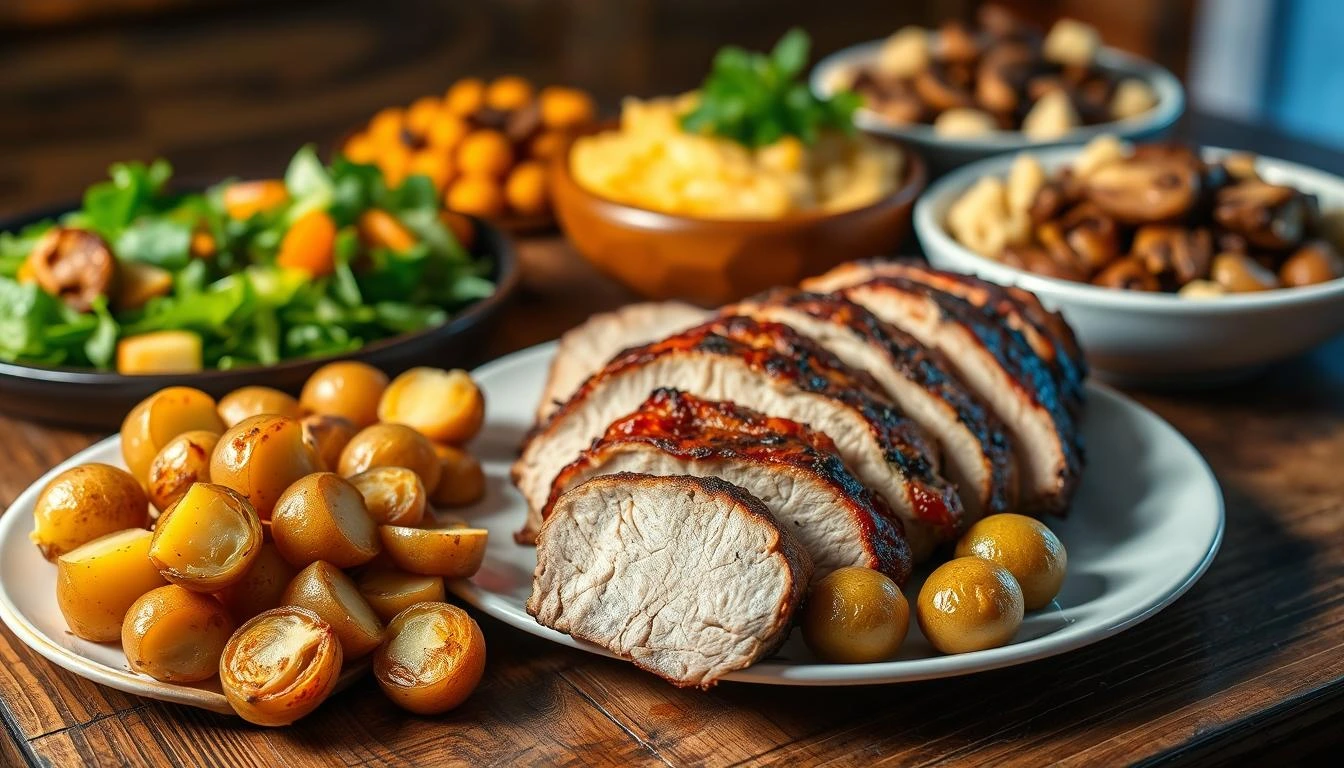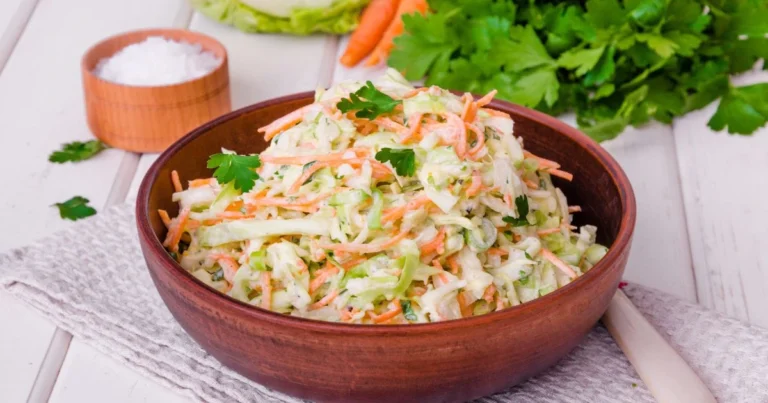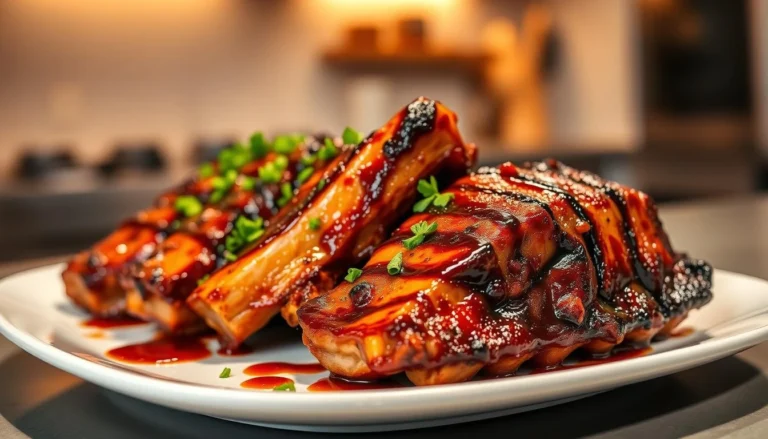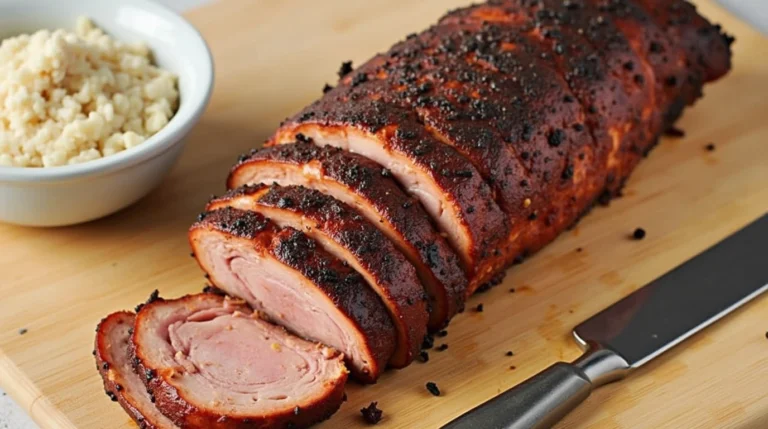What’s the Right Pork Loin Internal Temp?


Table of Contents
Every kitchen adventure has its moments of uncertainty, and cooking pork loin is no exception. I remember the first time I nervously hovered around my oven, wondering if I’d hit the perfect pork loin internal temp that would ensure both safety and incredible flavor. Cooking pork used to feel like a culinary minefield, with outdated advice about overcooking lurking around every corner.
Understanding the safe pork cooking temperature isn’t just about preventing foodborne illness—it’s about transforming a simple cut of meat into a juicy, tender masterpiece. Gone are the days of dry, tough pork that resembles shoe leather. Modern cooking guidelines have revolutionized how we approach preparing this versatile protein.
Whether you’re a home cook or aspiring chef, mastering the right internal temperature for pork loin can elevate your culinary skills. This guide will walk you through everything you need to know about cooking pork to perfection, ensuring each bite is both safe and delicious.
Key Takeaways
- Pork loin requires precise temperature control for safety and taste
- Modern cooking guidelines have changed traditional pork preparation methods
- Achieving the right internal temp prevents foodborne illness
- Cooking pork doesn’t mean sacrificing moisture or flavor
- Understanding temperature is key to perfect pork loin
Understanding Pork Loin Cuts
Selecting the perfect pork loin can elevate your cooking from good to exceptional. Knowing the different cuts and their unique characteristics is crucial for creating the best pork loin recipe. Pork loin offers versatility that can transform your home cooking experience.
When exploring pork loin cooking tips, you’ll discover several distinct cuts that can impact your meal’s flavor and texture:
- Center-cut loin: The most tender and lean option
- Blade-end loin: Contains more marbling for richer flavor
- Sirloin end: Slightly tougher but more economical
Choosing Your Perfect Cut
Your selection depends on several key factors. Bone-in cuts typically offer more flavor, while boneless options provide easier slicing. Consider these pork loin cooking tips when making your choice:
- Check fat content for moisture and taste
- Examine meat color – fresh pork should be pinkish-gray
- Look for consistent marbling
“The right cut makes all the difference in your cooking,” says professional chef Michael Roberts.
Quality Selection Strategies
When shopping, opt for fresh, high-quality meat from reputable butchers. The best pork loin recipe starts with premium ingredients. Look for cuts with minimal liquid in the packaging and smooth, uniform texture.
Remember that each cut requires slightly different preparation techniques to achieve maximum flavor and tenderness.
Importance of Proper Cooking Temperature
Cooking pork to the right temperature is crucial for both your health and culinary enjoyment. A comprehensive pork loin temperature guide helps you understand the critical balance between food safety and delicious meals.
When it comes to safe pork cooking temperature, precision is key. Undercooked pork can harbor dangerous pathogens that pose serious health risks to you and your family.
Health Risks of Undercooked Pork
Raw or undercooked pork can contain harmful microorganisms that may cause significant health problems. These potential risks include:
- Trichinosis, a parasitic infection
- Salmonella bacteria
- E. coli contamination
- Potential food poisoning
The Benefits of Cooking to the Right Temperature
Cooking pork to the recommended internal temperature offers multiple advantages:
- Eliminates harmful bacteria
- Ensures tender, juicy meat
- Enhances overall flavor profile
- Provides peace of mind about food safety
By following a reliable pork loin temperature guide, you protect your health while creating delectable meals that everyone can enjoy safely.
Recommended Internal Temperature for Pork Loin
Cooking pork loin to the perfect internal temperature ensures both safety and delicious flavor. Understanding pork loin internal temp is crucial for achieving the best results in your kitchen.
Food safety experts have specific guidelines for cooking pork to guarantee a delectable meal. The recommended pork loin doneness is now lower than traditional cooking recommendations, making your dishes juicier and more tender.
USDA Guidelines for Safe Pork Cooking
The United States Department of Agriculture (USDA) provides clear guidance for cooking pork safely. Here are the key points:
- The ideal pork loin internal temp is 145°F (63°C)
- Allow a 3-minute rest time after cooking
- Use a meat thermometer for accurate readings
Why 145°F Is the Magic Number
Cooking pork to 145°F strikes the perfect balance between food safety and culinary excellence. This temperature effectively eliminates harmful bacteria while preserving the meat’s natural moisture and tenderness.
| Pork Cut | Safe Internal Temperature | Rest Time |
|---|---|---|
| Pork Loin | 145°F | 3 minutes |
| Ground Pork | 160°F | No rest needed |
Pro tip: Remember that carryover cooking will continue to raise the internal temperature slightly after removing the meat from heat. This means you can take the pork loin off the heat when it reaches about 140°F, and it will reach the perfect 145°F during the resting period.
Best Cooking Methods for Pork Loin
Cooking pork loin perfectly requires understanding different techniques that help you achieve delicious results. Whether you prefer roasting or grilling, selecting the right method can transform your pork loin from ordinary to extraordinary.
Each cooking technique offers unique advantages for preparing pork loin. The key is maintaining the right pork loin roasting temp to ensure both safety and flavor.
Roasting in the Oven: Classic Technique
Roasting brings out the rich flavors of pork loin with minimal effort. Follow these steps for perfect results:
- Preheat oven to 375°F
- Season pork loin with herbs and spices
- Place in a roasting pan
- Cook until internal temperature reaches 145°F
- Let rest for 10 minutes before slicing
Grilling Tips for Perfect Pork
Grilling adds a smoky dimension to your pork loin. Preparation is crucial for achieving mouth-watering results:
- Trim excess fat
- Marinate for enhanced flavor
- Preheat grill to medium-high heat
- Use indirect heat method
- Monitor pork loin roasting temp carefully
Successful cooking pork loin depends on understanding temperature control and selecting the right method for your taste preferences.
How to Use a Meat Thermometer
Cooking the perfect pork loin requires precision, and a reliable pork loin thermometer is your secret weapon. Understanding how to use this essential tool can transform your cooking from guesswork to guaranteed success.
Selecting the right pork loin thermometer means considering several key factors that impact your cooking accuracy. Different types of thermometers offer unique benefits for measuring pork loin internal temp.
Choosing the Right Thermometer
When shopping for a meat thermometer, you’ll encounter several options:
- Instant-read digital thermometers – Quick and precise readings
- Leave-in probe thermometers – Monitor temperature during cooking
- Wireless thermometers – Track temperature remotely
Proper Placement for Accurate Readings
Accurate temperature measurement is crucial for safe and delicious pork loin. Follow these guidelines for the most reliable pork loin internal temp reading:
- Insert the thermometer into the thickest part of the meat
- Avoid touching bone, fat, or gristle
- Push the probe to the center of the meat
- Wait for the reading to stabilize
Pro tip: Always clean your pork loin thermometer between uses to prevent cross-contamination and ensure accurate readings every time.
Resting Period After Cooking
Perfecting your pork loin cooking tips goes beyond just reaching the right temperature. The resting period is a crucial step that can transform your meat from good to exceptional. After cooking, pork loin needs time to redistribute its delicious juices, ensuring maximum flavor and tenderness.

Why Resting Matters for Pork Loin Doneness
When you remove pork loin from heat, the internal temperature continues to rise. Resting allows the meat’s protein fibers to relax and reabsorb the flavorful juices that have been pushed to the center during cooking. This process prevents dry, tough meat and ensures a more succulent dining experience.
- Helps retain moisture throughout the meat
- Prevents juices from running out when cut
- Improves overall texture and flavor
Optimal Resting Time Guidelines
The length of resting depends on the size of your pork loin. A general rule for pork loin cooking tips is to let the meat rest for 5-10 minutes after cooking. This timeframe allows for proper juice redistribution without letting the meat cool completely.
| Pork Loin Size | Recommended Resting Time |
|---|---|
| Small Roast (1-2 lbs) | 5-7 minutes |
| Medium Roast (2-3 lbs) | 8-10 minutes |
| Large Roast (3-4 lbs) | 10-15 minutes |
Pro tip: Loosely tent your pork loin with aluminum foil during the resting period to keep it warm without trapping too much steam. This technique helps maintain the perfect pork loin doneness while preventing the meat from cooling too quickly.
Flavoring Your Pork Loin
Transforming a simple pork loin into a culinary masterpiece starts with understanding how to add delicious flavor. The best pork loin recipe isn’t just about cooking technique—it’s about creating layers of taste that make your dish unforgettable.
Cooking pork loin can be an exciting culinary adventure when you explore different flavoring methods. The right marinade or spice rub can elevate your dish from ordinary to extraordinary.
Marinating Magic: Unlocking Flavor Potential
Marinades work wonders for pork loin by:
- Tenderizing the meat
- Adding moisture
- Infusing deep, complex flavors
Pro tip: For the most effective marinade, allow your pork loin to soak for at least 2-4 hours, but no more than 24 hours to prevent breaking down the meat’s texture.
Spice Rubs That Sing
A great spice rub can transform your cooking pork loin experience. Consider these flavor combinations:
- Classic Herb Blend: Rosemary, thyme, garlic powder, salt, and black pepper
- Southwestern Kick: Chili powder, cumin, smoked paprika, brown sugar
- Asian-Inspired: Five-spice powder, ginger, garlic, and brown sugar
When applying a spice rub, press it firmly into the meat to create a flavorful crust that locks in moisture during cooking. Your best pork loin recipe starts with these simple yet powerful flavoring techniques.
Common Mistakes to Avoid
Cooking pork loin can be tricky, even for experienced home chefs. Understanding potential pitfalls is crucial to preparing a delicious and safe meal. Your pork loin temperature guide becomes an essential tool in avoiding common cooking errors that can compromise the quality of your dish.
Mastering pork loin cooking tips requires awareness of several critical mistakes that can derail your culinary efforts. Recognizing these errors will help you create a perfectly cooked, juicy, and flavorful pork loin every time.
Overcooking: The Silent Flavor Killer
Overcooking is the most significant threat to your pork loin’s quality. When meat reaches temperatures beyond the recommended 145°F, it begins to dry out and become tough. This mistake transforms a potentially succulent dish into a disappointing, chewy experience.
- Watch your internal temperature carefully
- Use a reliable meat thermometer
- Remove meat from heat just before reaching target temperature
- Allow for carryover cooking during resting period
Ignoring Temperature Readings
Relying on visual cues or preset cooking times can lead to disastrous results. Your pork loin temperature guide is your most reliable cooking companion. Digital meat thermometers provide instant, accurate readings that eliminate guesswork.
“Precision is the key to perfect pork loin. Trust your thermometer, not your eyes.” – Professional Chef
| Mistake | Consequence | Solution |
|---|---|---|
| Overcooking | Dry, tough meat | Remove at 140°F, rest to reach 145°F |
| Not using thermometer | Inconsistent results | Invest in digital meat thermometer |
| Skipping resting period | Uneven moisture distribution | Rest meat 5-10 minutes after cooking |
By avoiding these common mistakes and following professional pork loin cooking tips, you’ll elevate your culinary skills and consistently prepare mouth-watering meals that impress family and friends.
Pairing Sides with Pork Loin
Creating the perfect meal goes beyond cooking the best pork loin recipe. The right side dishes can elevate your pork loin from good to extraordinary. When cooking pork loin, selecting complementary sides is crucial for a balanced and delicious dining experience.

Vegetable Companions for Pork Loin
Choosing the right vegetables can transform your pork loin meal. Fresh, seasonal vegetables work best when preparing your pork loin recipe. Consider these vegetable options:
- Roasted Brussels sprouts with garlic
- Honey-glazed carrots
- Caramelized green beans
- Herb-roasted asparagus
Starch Selections to Complete Your Meal
Starches provide the perfect foundation for your pork loin dish. Explore these delectable options:
| Starch Option | Preparation Method | Flavor Profile |
|---|---|---|
| Garlic Mashed Potatoes | Creamy, whipped | Rich and comforting |
| Wild Rice Pilaf | Toasted and simmered | Nutty and sophisticated |
| Roasted Sweet Potato | Oven-roasted with herbs | Sweet and savory |
Sauces to Enhance Your Pork Loin
A great sauce can take your cooking pork loin skills to the next level. Try these flavor-packed options:
- Apple cider reduction
- Dijon mustard cream sauce
- Balsamic glaze
- Herb-infused pan sauce
Remember, the key to a spectacular pork loin meal is balance. Mix and match these side dishes to create a memorable dining experience that will impress your family and guests.
Cooking Times by Weight
Mastering pork loin roasting temp requires understanding how cooking times vary with weight and preparation method. The right approach can transform your pork loin from ordinary to extraordinary, ensuring juicy and flavorful results every time.
Cooking times for pork loin depend on several key factors. Your pork loin cooking tips should always prioritize both weight and cooking method to achieve perfect results.
General Cooking Time Guidelines
Different weights require specific cooking strategies. Here’s a comprehensive guide to help you navigate pork loin preparation:
- 1-2 pound roasts: 20-25 minutes per pound
- 3-4 pound roasts: 15-20 minutes per pound
- Bone-in cuts: Add 5-10 minutes extra cooking time
Method-Specific Cooking Adjustments
Your cooking method significantly impacts total preparation time. Pork loin roasting temp varies depending on whether you’re using an oven, grill, or smoker.
| Cooking Method | Temperature | Approximate Time |
|---|---|---|
| Oven Roasting | 350°F | 20-25 minutes/pound |
| Grilling | 375-400°F | 15-20 minutes/pound |
| Slow Cooker | Low Setting | 6-8 hours |
Pro tip: Always use a meat thermometer to confirm internal temperature reaches 145°F for safe, perfect pork loin every time.
Storage Tips for Leftover Pork Loin
Preserving the delicious flavor and quality of your pork loin after cooking requires careful storage and reheating techniques. Proper handling ensures you can enjoy your meal safely and maintain its delectable taste.
When it comes to pork loin cooking tips, storage is a critical step in maintaining food safety and flavor preservation. Follow these essential guidelines to keep your leftover pork loin at its best:
Cooling and Storing Safely
- Cool cooked pork loin to room temperature within 2 hours of cooking
- Use airtight containers or sealed plastic bags for storage
- Refrigerate promptly at 40°F or below
- Consume stored pork loin within 3-4 days for optimal taste and safety
Reheating to Maintain Flavor and Safety
Reheating leftover pork loin requires careful attention to safe pork cooking temperature. Use these methods to ensure your meat remains juicy and delicious:
- Oven Method: Preheat to 325°F and cover with foil to prevent drying
- Microwave Method: Use medium power and cover to retain moisture
- Always reheat to an internal temperature of 165°F to ensure food safety
Pro tip: Add a splash of broth or water when reheating to help maintain the pork loin’s moisture and prevent it from becoming tough or dry.
Remember, proper storage and reheating are key to enjoying delicious leftover pork loin while keeping your meals safe and flavorful!
Final Thoughts on Pork Loin Cooking
Mastering the art of pork loin cooking requires attention to detail and a commitment to food safety. Understanding the pork loin internal temp is crucial for creating delicious and safe meals that your family will enjoy. The key takeaway is simple: precision matters when preparing this versatile cut of meat.
Your journey to creating the best pork loin recipe starts with investing in a reliable meat thermometer and learning proper cooking techniques. Remember that 145°F is your target temperature for perfectly cooked pork. This ensures both optimal flavor and safety, eliminating any concerns about harmful bacteria while maintaining the meat’s juicy texture.
Key Insights to Remember
Don’t be afraid to experiment with different marinades, spice rubs, and cooking methods. Each technique can bring out unique flavors in your pork loin. Whether you’re roasting in the oven, grilling outdoors, or trying a new recipe, your newfound knowledge will help you create restaurant-quality dishes right in your own kitchen.
Your Culinary Adventure Awaits
Cooking pork loin is an art that improves with practice. Start with the guidelines you’ve learned, but don’t be afraid to add your personal touch. With patience and attention to temperature, you’ll soon be preparing mouthwatering pork loin dishes that will impress your family and friends.
FAQ
What is the safe internal temperature for pork loin?
How long should I let my pork loin rest after cooking?
Can I cook pork loin to a lower temperature?
What’s the best way to check the internal temperature?
How long does it take to cook a pork loin?
Can I marinate my pork loin before cooking?
How do I store leftover pork loin?
What’s the difference between pork loin and pork tenderloin?
There are no reviews yet. Be the first one to write one.





